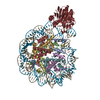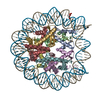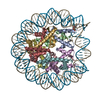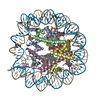+Search query
-Structure paper
| Title | Structural basis for APE1 processing DNA damage in the nucleosome. |
|---|---|
| Journal, issue, pages | Nat Commun, Vol. 13, Issue 1, Page 5390, Year 2022 |
| Publish date | Sep 14, 2022 |
 Authors Authors | Tyler M Weaver / Nicole M Hoitsma / Jonah J Spencer / Lokesh Gakhar / Nicholas J Schnicker / Bret D Freudenthal /  |
| PubMed Abstract | Genomic DNA is continually exposed to endogenous and exogenous factors that promote DNA damage. Eukaryotic genomic DNA is packaged into nucleosomes, which present a barrier to accessing and ...Genomic DNA is continually exposed to endogenous and exogenous factors that promote DNA damage. Eukaryotic genomic DNA is packaged into nucleosomes, which present a barrier to accessing and effectively repairing DNA damage. The mechanisms by which DNA repair proteins overcome this barrier to repair DNA damage in the nucleosome and protect genomic stability is unknown. Here, we determine how the base excision repair (BER) endonuclease AP-endonuclease 1 (APE1) recognizes and cleaves DNA damage in the nucleosome. Kinetic assays determine that APE1 cleaves solvent-exposed AP sites in the nucleosome with 3 - 6 orders of magnitude higher efficiency than occluded AP sites. A cryo-electron microscopy structure of APE1 bound to a nucleosome containing a solvent-exposed AP site reveal that APE1 uses a DNA sculpting mechanism for AP site recognition, where APE1 bends the nucleosomal DNA to access the AP site. Notably, additional biochemical and structural characterization of occluded AP sites identify contacts between the nucleosomal DNA and histone octamer that prevent efficient processing of the AP site by APE1. These findings provide a rationale for the position-dependent activity of BER proteins in the nucleosome and suggests the ability of BER proteins to sculpt nucleosomal DNA drives efficient BER in chromatin. |
 External links External links |  Nat Commun / Nat Commun /  PubMed:36104361 / PubMed:36104361 /  PubMed Central PubMed Central |
| Methods | EM (single particle) |
| Resolution | 3.1 - 4.0 Å |
| Structure data | EMDB-26336, PDB-7u50: EMDB-26337, PDB-7u51: EMDB-26338, PDB-7u52: EMDB-26339, PDB-7u53: |
| Source |
|
 Keywords Keywords | DNA BINDING PROTEIN/DNA /  nucleosome / nucleosome /  DNA damage / DNA damage /  DNA repair / DNA repair /  DNA BINDING PROTEIN / DNA BINDING PROTEIN-DNA complex DNA BINDING PROTEIN / DNA BINDING PROTEIN-DNA complex |
 Movie
Movie Controller
Controller Structure viewers
Structure viewers About Yorodumi Papers
About Yorodumi Papers












